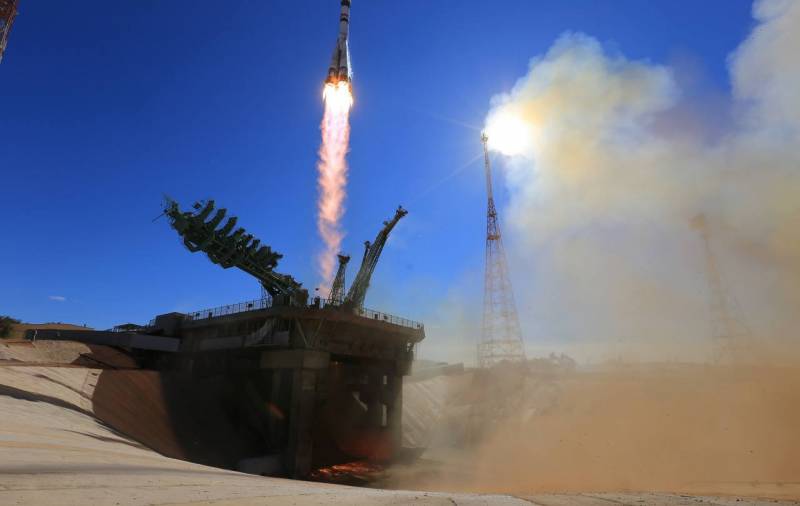Billion dollar new space race
On August 11, a Soyuz-2.1b medium rocket was launched from the Vostochny cosmodrome with the Luna-25 station. The project has the status of the first scientific mission in the history of the Russian Federation to a natural satellite of the Earth. The first expedition to the moon in 50 years suggests the attempts of Roskosmos to return to our country the palm in the field of space exploration. We will try to figure out how likely this scenario is and how much money will need to be spent to achieve this goal.
It is worth noting that the last time Russian scientists sent a research mission to the moon was back in the days of the Soviet Union. After the recent launch of the new station, the head of Roscosmos, Yuri Borisov, said that Luna-2027 could be launched in 26, Luna-2028 in 27, and Luna-2030 sometime by 28. Such statements may indicate that in the coming years the state corporation really intends to increase the Russian presence in space, engaging in active research of the celestial body closest to Earth.
Another factor in favor of this assumption may be the financial forecasts presented in the document “Strategic development of the state corporation for space activities Roscosmos for the period up to 2025 and up to 2030”, which was published in 2017. For example, it says that the share of the Russian Federation in the global space market by 2030 should be 9,5%, having increased by 2016% compared to 4,7. In addition, it is necessary to pay attention to the fact that in April of this year, the President of our country, Vladimir Putin, at a meeting with Yuri Borisov, emphasized that the volume of funding for space activities in Russia in 2023 will amount to more than 251 billion rubles (224 billion in 2022).
In addition, the Federal Space Program for 2016-2025 is currently operating in Russia. The total amount of its financing is 1406 billion rubles, it is also possible to allocate additional funds after 2022. The key areas of this program include ensuring the state policy in the field of space activities, maintaining the required composition of the orbital constellation of spacecraft, as well as the implementation of a manned program and the creation of scientific andtechnical bases for innovative space complexes and systems.
Under the current political conditions, the fate of the Russian segment of the International Space Station is extremely interesting. The ISS is a kind of symbol of the joint exploration of outer space by different states. In 2022, many high-profile statements were made from the lips of prominent Russian politicians and managers about Russia's impending withdrawal from this project. Thus, the ex-head of Roscosmos Dmitry Rogozin stated that the Russian Federation would continue to work on the orbital station until 2024 in accordance with the deadlines set by the government of the Russian Federation, emphasizing that the future of the domestic segment of the ISS would depend on the political conditions in which our country would be . The most interesting thing is that six months later, Roscosmos decided to extend the life of the Russian part of the International Space Station until 2028. It would be extremely interesting to see how Dmitry Rogozin himself commented on these events, apparently, during this time the international situation has stabilized and political pressure on Russia from states unfriendly to our country has decreased.
At the moment, it is known that Roscosmos is going to request 160,4 billion rubles from the Russian government to maintain the work of the domestic segment of the ISS from 2024 to 2028, which indicates a reduction in funding by about 10%. It is also worth emphasizing that the head of the Space Policy Institute, Ivan Moiseev, in his commentary for Izvestia, noted that the costs of the Russian module of the ISS amount to almost 90% of the budget of all manned projects, which are one of the key areas within the Federal Space Program. This situation largely hinders the development of Roscosmos' own projects, in which only states friendly to the Russian Federation will be involved.
The international situation requires the Russian Federation to coordinate efforts in space exploration with countries that are close to us in the modern political system of coordinates. One of these projects can be called the International Lunar Space Station, the main partner of Roscosmos in its implementation will be the People's Republic of China. The construction of the station is scheduled for 2031-2035. The main issue in the implementation of this project will be funding, the creation of a full-fledged station on the Moon is a rather expensive undertaking. For example, the American Apollo space program, which consists of organizing manned landings on the moon, cost the United States approximately 136 billion dollars at the rate of 2005. It can be assumed that the Russian-Chinese project, which is more global in nature, will cost a much larger amount.
In conclusion, I would like to note that recently the Russian Federation has been paying more and more attention to the space program, in many ways trying to oppose it to the projects of countries that have been leaders in this industry for many years (the United States of America and their partners). All these processes are in many ways acquiring political overtones, reminiscent of the space race of the last century, with the era of which the most ambitious achievements of mankind in the field of astronautics are associated. At present, it is becoming clear that the rules of the game have changed in many respects; serious success in this area can be achieved only in close cooperation with other states. Therefore, it is extremely important for Russia to find reliable allies who will be interested in the implementation of joint space programs. To achieve this goal, countries should be as similar as possible to both economicas well as political interests.

Information